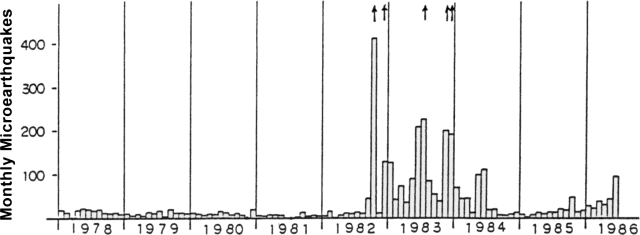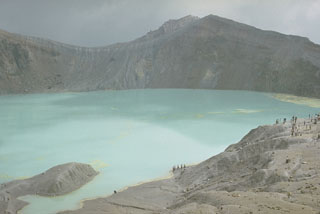Report on Kusatsu-Shiranesan (Japan) — June 1986
Scientific Event Alert Network Bulletin, vol. 11, no. 6 (June 1986)
Managing Editor: Lindsay McClelland.
Kusatsu-Shiranesan (Japan) Increase in microearthquakes since 1984
Please cite this report as:
Global Volcanism Program, 1986. Report on Kusatsu-Shiranesan (Japan) (McClelland, L., ed.). Scientific Event Alert Network Bulletin, 11:6. Smithsonian Institution. https://doi.org/10.5479/si.GVP.SEAN198606-283120
Kusatsu-Shiranesan
Japan
36.618°N, 138.528°E; summit elev. 2165 m
All times are local (unless otherwise noted)
Monthly frequency of microearthquakes recorded at the volcano reached 96 in June, the highest since the active phase of 1982-84. A gradual increase in seismicity began last year (figure 2).
 |
Figure 2. Monthly seismicity at Kusatsu-Shirane, 1978-86. Arrows indicate five eruptions in 1982 and 1983. |
Geological Summary. The Kusatsu-Shiranesan complex, located immediately north of Asama volcano, consists of a series of overlapping pyroclastic cones and three crater lakes. The andesitic-to-dacitic volcano was formed in three eruptive stages beginning in the early to mid-Pleistocene. The Pleistocene Oshi pyroclastic flow produced extensive welded tuffs and non-welded pumice that covers much of the E, S, and SW flanks. The latest eruptive stage began about 14,000 years ago. Historical eruptions have consisted of phreatic explosions from the acidic crater lakes or their margins. Fumaroles and hot springs that dot the flanks have strongly acidified many rivers draining from the volcano. The crater was the site of active sulfur mining for many years during the 19th and 20th centuries.
Information Contacts: JMA.

